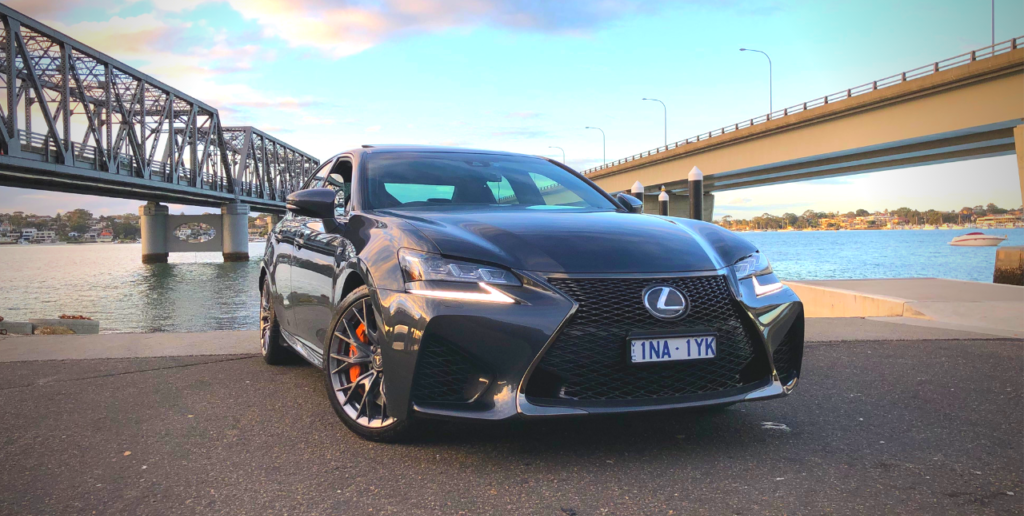Our Rating
The GS F provides the perfect balance between a sport saloon and a luxurious family sedan. The V8 makes an intoxicating sound, but does come with a major drawback: fuel efficiency. The GS F handles itself well for its size and offers the sport saloon market a rarity, a naturally aspirated V8, which differentiates it from turbo and six cylinder competitors.
-
Engine & Drivetrain
-
Performance
-
Fuel Economy
-
Interior
-
Gadgets & Technology
-
Safety
-
Ride & Comfort
-
Practicality
-
Affordability
-
Behind the Wheel
Engine
The new GS F is powered by the long standing 5.0-litre V8 that has most certainly stood the test of time. This same engine powers the Lexus RC F and LC500 amongst other older models. It has a whopping 351kW of power and 530Nm of torque.
These power figures are staggering, particularly given that this car has no forced induction, turbo/s, supercharger etc. Just a straight naturally aspirated V8. For comparison, the BMW M3 and M4, although lacking 2 cylinder 2-litres, puts out 317kW thanks to it’s twin turbo engine.
I can’t even begin to imagine what this engine would put out with a turbo, or two.. But, it doesn’t need them. It is powerful enough to lug a spacious luxury saloon.
Peak power kicks in at 7100rpm whilst peak torque is at 4800rpm. As you would expect with a naturally aspirated V8, a fair bit of revving is needed before peak power and torque kick in. And this is noticeable even with the exhaust note as it gets noticeably fiercer from 5000rpm onwards.
Performance
The engine provides plenty of grunt to throw you back in your seat, completing 0-100kmh in just 4.6 seconds. All that power goes straight to the rear wheels meaning it can be a bit difficult to tame if you put your foot down on the power to aggressively with some wheel spin/squeals, especially in the wet/dew.
Given that the car weighs almost 1900kg, it needs all that power to push it. For such a heavy car, it does incredibly well to handle itself with all that chunk. You can feel the weight of the car, but not so horrible that I would define the car as a boat. It’s still fairly controlled and direct when steering.
Taking it around corners, it performs well in sport+ when the steering is tightened up. Lexus’s new Adaptive Variable Suspension (AVS) has 30 different levels of damping force governed by seven different program ‘strategies’. It adapts surprisingly well to each specific situation, although I would like the option to select the suspension settings on the screen.
We drove the GS F in all drive modes including eco, normal, sport and sport+ mode to compare the difference in performance. Eco, forget it. Normal is best suited for daily driving, but it can take its time to drop the gears and take off. Sport mode is unreal, with gears held higher, shifts quicker, corners tighter. And sport+ mode, even better than sport mode. The ride firms up, but not to the extent that it’s uncomfortable, and enhances all performance aspects of the car.
Fuel Economy
Lexus claims fuel economy to be 11.3L/100km on the combined cycle. The GS F also has a 66 litre fuel tank. We would have thought this would have been bigger, given the V8 monster that lies under the bonnet, but also as the LC500 (with the same engine) has an 82 litre tank.
Our testing returned figures of around 15.5L/100km on the combined cycle. Pure city driving can see that rise to between 19-22L/100, contrasting to pure motorway driving which can drop to around 9-12L/100km. Perhaps cylinder deactivation might help lower these figures.
But then again, this is a 5.0-litre V8! This isn’t the car you buy to have performance AND economy, you can’t have it all. Expect to fill up frequently with premium fuel with this beast.
Interior & Technology
The interior of the GS F is as you would expect for a car in this market: luxurious and extra. The list of features in this car is so elongated that I am still learning new things about it to this day.
At the front, there are large, comfortable leather seats with a bucket-ish design. These seats are comfortable enough, but they lack a bit of leather in the back area. I understand that this was to provide that bucket/racey sport seat look, but in this luxury grand tourer, more cushioning would be ideal.
Both front seats are heated and cooled with 3 levels of heat/cooling power. There is also an auto option which presumably dictates how much heating/cooling you need depending on the temperature. The left and right seats in the back are also heated and can be adjusted by the arm rest that comes forward from the middle seat.
This ‘arm rest’ is unreal. It allows the left and right passengers to change the temperature for the rear seats (as there is tri-zone climate, one zone at the back, and two zones at the front). It also has the heating options, again with auto heating – although a rear passenger may leave this on and if nobody sits in that back seat for a while, it could be wasting a significant of energy. The arm rest also lets the passengers change the audio mode, track and volume which may cause an internal battle between passengers but still good to have the option.
The sunroof is placed towards the front of the vehicle and has an option to be raised/lowered without opening completely. However, full panoramic roofing with large sunroofs are slowly becoming the status quo.
The head unit is huge, 12.3 inches to be exact, but it is placed so far back that it’s unreachable by the driver. This is why the screen isn’t touch screen, but instead is controlled by the little mouse mechanism. This can get incredibly frustrating and a fair bit dangerous trying to manoeuvre mid driving. Ideally, the head unit could have been moved forward, with touch screen and Apple CarPlay/Android Auto. Lexus and Toyota really need to adapt these, and fast.
The rest of the interior is considerably comfortable. The middle seat in the back row could be a tad less firm, but that’s just me being picky. For 4 people, this car is incredibly comfortable, but adding a 5th might make a road trip a bit of a squeeze.
Safety
The Lexus GS F has not been tested by ANCAP.
Safety Features include 10 airbags including dual-front, front-side, rear-side and full-length curtain, ABS, ESC, pre-collision warning, blind-spot monitor, lane-keep assistance, front and rear parking sensors, reverse-view camera, active cruise control and emergency braking.
We found the cruise control to do well in adapting to how close/far it remains from the car in front. The lane-keep assistance will happily keep you in your lane for up to 10 seconds before switching the system off (so it’s not a driverless car – well, for 10 seconds it can be).
Ride & Comfort
The GS F comfortably handles a wide array of situations from bumpy, pot-hole infused roads, to windy national parks. Despite the profile of the tires being quite thin (275/35/19 rear, 255/35/19 front), it handles bumps with ease.
The size of this car makes it perfect for the family with all the room throughout the car thanks to its chunky form factor, along with the largest boot ever seen in a sedan.
Around bendy roads, the GS F controls itself surprisingly well for a 2 tonne machine. With any rear wheel drive car, it’s about controlling the exits around windy roads and making sure you don’t floor it too early. The GS F avoids getting uncontrollable quite well thanks to its torque vectoring and new Adaptive Variable Suspension.
In Sport and Sport+ mode, the ride is much more responsive and firm, enhancing the thrill factor of the drive. The 8 speed gearbox strides through the gears, clunk-free. Slowing down feels as if the car is in neutral, it’s almost unrecognisable that the car is dropping down (in some situations) 7 gears. Props to Lexus for this.
The GS F feels like a luxurious car when it wants to be, and a track beast when it wants to be. It provides the best of both worlds. Cars like the M4 and AMG coupes don’t provide the practical element that the GS F boasts, which makes the GS F the perfect luxury grand tourer.
Warranty & Servicing
Warranty: Four years/100,000km.
Servicing: There’s no capped-price servicing program with Lexus vehicles, but the first 12 month or 15,000km service is free followed by ‘recommended’ pricing of $709.13/$696.05/$709.13 for the following three services which can inevitably lead to higher costs after replacing small parts here and there.
Pricing
The GS F comes in at $155,940 plus on-road costs.
Building and pricing a GS F on the Lexus website right now returns a driveaway price of:
– $166,973 for the stock GS F
– $169,598 for Enhancement Pack 1 or Enhancement Pack 2
– $172,223 for Enhancement Pack 3
EP1 has “forged 19 inch polished alloy wheels. EP2 has “carbon fibre ornamentation”. EP3 both forged alloy wheels and the ornamentation.
Overall
We can’t sit here and deny that performance is well down on its key rivals from Mercedes-Benz and BMW, which generate huge power and torque from their twin-turbocharger systems (E63 S AMG 450kW/850Nm and M5 Competition 460kW/750Nm respectively). But on many roads roads, you could drive the GS F with your pedal to the metal most of the time knowing the rear won’t play up and cause a severe fright. It was not life threateningly intimidating.
But, at a much cheaper price than these more lucrative cars, the GS F provides a perfect balance between super saloon and luxury family car. The V8 makes an unbelievable note, and there is absolutely no delay due to the lack of turbo’s.
The interior could do with some improvements, but overall, the features list is endless with this car, making you feel luxurious the moment you sit inside of it. It can also easily fit 4 passengers comfortably, who can all change temperature, seat heating and audio player settings.
For the price, there is a lot of car on offer with the GS F, but we can’t promise that your fuel bill will be ‘conservative’. This car is made to be enjoyed and we loved testing it in many different conditions which it had no problems with.
ALL our videos of the Lexus GS F below:
Comprehensive review:
In-depth walkthrough:
Full Exterior & Interior Tour:
Exhaust Sound:
Urban test drive:
All tech settings and modes:






